| کد مقاله | کد نشریه | سال انتشار | مقاله انگلیسی | نسخه تمام متن |
|---|---|---|---|---|
| 2909878 | 1174592 | 2014 | 4 صفحه PDF | دانلود رایگان |
AimsThe purpose of this study was to determine the microbiology of diabetic foot infections and to assess the antibiotic susceptibility patterns.Materials and methodsA cross sectional retrospective study of 35 patients with diabetic foot infections hospitalized at the internal medicine clinic of Dr. Mintohardjo Navy Hospital, Jakarta. The data were collected from patient medical records retrospectively. The classification of the diabetic foot infections was evaluated according to Meggit–Wagner's Classification. Identification of causative microorganisms was performed by standard microbiologic methods. Antibiotic susceptibility testing was performed using disk-diffusion method.ResultsDuring January to December 2012, a total of 288 of diabetic patients were admitted to hospital, and 35 patients had diabetic foot infections. According to Meggit–Wagner's classification the most common disease was grade 3 in 31.4% patients, followed by grade 2 in 25.7%, and grade 4 in 17.3% of patients. Conservative diabetic control care was carried out in 37.1% of patients, and surgical intervention was carried out in 62.9% of patients. A total of 59 pathogens were identified. The most common infecting microorganism isolated on pus cultures was Staphylococcus aureus (47.5%), followed by Pseudomonas spp (16.9%), E. coli (10.2%), Streptococcus spp. (8.5%), Enterobacter spp. (7.0%), Proteus spp. (6.7%), and Acinetobacter spp. (3.2%). Overall, 37.2% of the diabetic foot infection caused by a single microorganism, and 62.8% had polymicrobial infections. The most frequently administrated antibiotic was ceftriaxone (40.0%), followed by ciprofloxacin (11.4%), and meropenem (8.6%).ConclusionDiabetic foot infections (62.8%) were polymicrobial. S. aureus was most commonly found in the foot infection. Most of the microorganisms isolated from diabetic foot infection were resistant to many types of antibiotics.
Journal: Diabetes & Metabolic Syndrome: Clinical Research & Reviews - Volume 8, Issue 4, October–December 2014, Pages 221–224
